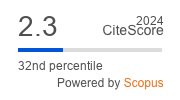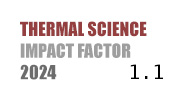THERMAL SCIENCE
International Scientific Journal
NUMERICAL SIMULATION OF DROPLET EVAPORATION BASED ON THE SMOOTHED PARTICLE HYDRODYNAMICS METHOD
ABSTRACT
Based on the smoothed particle hydrodynamics method, a numerical model of smoothed particle hydrodynamics in multi-phase flow evaporation accompanied with heat and mass transfer has been established, and phase transition of droplet evaporation is simulated. In this paper, an smoothed particle hydrodynamics mass transfer equation of gas phase in evaporation are proposed based on Fick’s law. In order to solve the problem of large mass difference of particles at the phase interface during evaporation, the particle splitting and merging techniques are introduced, and the tensile instability of particles during the splitting and merging is weakened by artificial stress. Besides, by adding the surface tension model, the mutual penetration of particles at the gas-liquid interface is effectively prevented. On this basis, the evaporation of single droplet and interacting droplets without gravity is simulated. The results show that the evaporation time of single droplet in this study conforms to D2 law and is within the theoretical range. There is a great influence between interacting droplets in the process of evaporation. Only when dimensionless number C (droplet spacing/droplet diameter) is larger than eight, the influence between droplets can be approximately ignored.
KEYWORDS
PAPER SUBMITTED: 2023-03-11
PAPER REVISED: 2023-04-21
PAPER ACCEPTED: 2023-04-22
PUBLISHED ONLINE: 2023-05-13
THERMAL SCIENCE YEAR
2023, VOLUME
27, ISSUE
Issue 5, PAGES [3745 - 3756]
- Godsave, G. A. E., Studies of the Combustion of Drops in A Fuel Spray - The Burning of Single Drops of Fuel, Symposium (International) on Combustion, 4 (1953), 1, pp. 818-830
- Spalding, D. B., The Combustion of Liquid Fuels, Symposium (International) on Combustion, 4 (1953), 1, pp. 847-864
- Nomura, H., et al., Experimental Study on High-Pressure Droplet Evaporation Using Microgravity Conditions, Symposium (International) on Combustion, 26 (1996), 1, pp. 1267-1273
- Labowsky, M., Calculation of the Burning Rates of Interacting Fuel Droplets, Combustion Science and Technology, 22 (1980), 5-6, pp. 217-226
- Sangiovanni, J. J., Labowsky M., Burning Times of Linear Fuel Droplet Arrays: A Comparison of Experiment and Theory, Combustion and Flame, 47 (1982), 0010-2180, pp. 15-30
- Marberry, M., et al., Effect of Multiple Particle Interactions on Burning Droplets, Combustion and Flame, 57 (1984), 3, pp. 237-245
- Castanet, G., et al., Evaporation of Closely-Spaced Interacting Droplets Arranged in a Single Row, International Journal of Heat and Mass Transfer, 93 (2016), 0017-9310, pp. 788-802
- Chiang, C. H., Sirignano, W. A., Interacting, Convecting, Vaporizing Fuel Droplets with Variable Properties, International Journal of Heat and Mass Transfer, 36 (1993), 4, pp. 875-886
- Tanguy, S., et al., A Level Set Method for Vaporizing Two-Phase Flows, Journal of Computational Physics, 221 (2007), 2, pp. 837-853
- Safari, H., et al., Consistent Simulation of Droplet Evaporation Based on the Phase-Field Multi-Phase Lattice Boltzmann Method, Physical Review E, 90 (2014), 3, 033305
- Safari, H., et al., Extended Lattice Boltzmann Method for Numerical Simulation of Thermal Phase Change in Two-Phase Fluid-Flow, Physical Review E, 88 (2013), 1, 013304
- Nikolopoulos, N., et al., A Numerical Investigation of the Evaporation Process of a Liquid Droplet Impinging on a Hot Substrate, International Journal of Heat and Mass Transfer, 50 (2007), 1-2, pp. 303-319
- Tonini, S., Cossali, G. E., A Multi-Component Drop Evaporation Model Based on Analytical Solution of Stefan-Maxwell Equations, International Journal of Heat and Mass Transfer, 92 (2016), 0017-9310, pp. 184-189
- Monaghan, J. J., Smoothed Particle Hydrodynamics, Annual Reviews of Astronomy and Astrophysics, 30 (1992), pp. 543-574
- Monaghan, J. J., et al., Solidification Using Smoothed Particle Hydrodynamics, Journal of Computational Physics, 206 (2005), 2, pp. 684-705
- Zhang, B. W., et al., Numerical Simulation of Droplet Impinging Icing Process on a Low Temperature Wall with Smoothed Particle Hydrodynamics Method, Thermal Science, 26 (2022), 4B, pp. 3373-3385
- Yang, X. F., Kong, S. C., Smoothed Particle Hydrodynamics Method for Evaporating Multi-Phase Flows, Physical Review E., 96 (2017), 3, 033309
- Wang, D. D., et al., Numerical Simulation of Droplet Evaporation Based on Smooth Particle Fluid Dynamics Method (in Chinese), Journal Of Propulsion Technology, 42 (2021), 02, pp. 382-394
- Li, L. H., et al., The SPH-ASR Study of Drop Impact on a Heated Surface with Consideration of Inclined Angle and Evaporation, Engineering Analysis with Boundary Elements, 141 (2022), 0955-7997, pp. 235-249
- Cleary, P. W., Modelling Confined Multi-Material Heat and Mass-Flows Using SPH, Applied Mathematical Modelling, 22 (1998), 12, pp. 981-993
- Yan S. L., et al., Study on the Flow and Heat Transfer of Water Droplets Hitting a Constant Temperature Wall Based on Sph Method (in Chinese), Energy Engineering, 01 (2018), pp. 1-8
- Morris, J. P., Simulating Surface Tension with Smoothed Particle Hydrodynamics, International Journal for Numerical Methods in Fluids, 33 (2000), 3, pp. 333-353
- Qiang, H. F., et al., Numerical Simulation of 2-D Droplet Vollision Based on SPH Method of Multi-Phase Flow with Large Density Difference (in Chinese), Acta Physica Sinica, 62 (2013), 21, 214701
- Bonet, J., Lok, T. S. L., Variational and Momentum Preservation Aspects of Smooth Particle Hydrodynamic Formulations, Computer Methods in Applied Mechanics and Engineering, 180 (1999), 1-2, pp. 97-115
- Turns, S. R., Introduction Combustion, McGraw-Hill Companies, New York, USA, 1996

